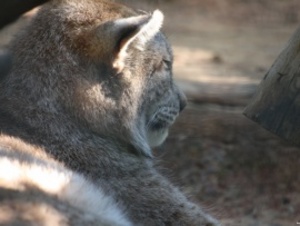Big Cats of the United States
Puma (Puma concolor)
Despite the contraction of their range there are still large wild cats in North America and in some cases their populations are stable or rebounding. Most people are familiar with the quintessential American big cat – the Puma. It is called several names including mountain lion and cougar. An elusive and stealthy predator it has been called Ghost Cat by Native Americans. It is a capable hunter adapting to widely varied regions and hunting conditions. Puma will stalk their prey in silence and at a distance or wait in ambush. They hunt at night or during the day. This adaptable cat has an extensive range from the Canadian Rockies to deep in South America.
The puma’s actually range may be much larger with large cats matching its description spotted as far East as Maine. There is a small population of puma in Florida. Puma have been known to take prey as large as moose, domestic cattle or elk. Though shy they will attack humans under the right circumstances. Human settlement in heavily wooded and wild areas has put humans in the hunting range of this premiere hunter.
Bobcat (Lynx rufus)
With a range greater than any other big cat in America the bobcat is a successful and adaptive hunter. The bobcat’s original range included every state except Hawaii. Though not confirmed, bobcats have been spotted everywhere in the United States with the exception of highly urbanized areas or areas where they were exterminated to protect livestock. Those areas, however, are experiencing a resurgence of this opportunistic predator.
Bobcats resemble, in many ways, an impossibly large house cat. Larger than all domestic breeds, bobcats have coloration that blends well with every habitat. They hunt small animals but have been known to take even small deer as prey. Less elusive than lynx or cougars they hunt around dawn and dusk when their primary prey, rabbits and hares, are most active.
Canadian Lynx (Lynx Canadensis)
Related to European variety of Lynx, the Canadian lynx is a shy and elusive hunter. They prey on rabbits and hare, primarily hunting snowshoe hares. The lynx’ range is the most northerly parts of the lower United States, Alaska and Canada – the same range as the snowshoe hare. They tend to be solitary hunters but have been observed hunting cooperatively. Where lynx and bobcats share range the lynx has tended to yield to the larger more aggressive bobcat. Lynx coloration gives it good camouflage for its northerly range and paired with its shy nature makes this cat hard to spot.
Jaguar (Panthera onca)
The jaguar is the rarest of American big cats with a very small part of the American southwest as the most northerly part of it overall range. The majority of its range stretches through out Mexico, Central and South America. This largest of the American big cats resembles it distant cousin, the leopard, more than any other cat. Blockier and stouter in shape and size the jaguar prefers jungles and forests near water as its hunting territory. The jaguar’s closest relatives are all the large African and Asian cats. It is the only species of Panthera in the New World. Like other big cats it adapts its hunting behavior to it prey hunting when its prey is most active regardless of whether that is day, night, dusk or dawn. Jaguars love the water and will take fish, caimans, capybaras and other water living and loving animals as prey.
Jaguarundi (Herpailurus yaguarandi)
Smallest of the American big cats it is about the size of a house cat with short legs and coloration that resembles the puma’s with wide variations depending on habitat. Jaguarundis have been spotted in the American southwest, mostly in Texas and New Mexico with a small transplanted population in Florida. They prey on small animals, birds, fish and reptiles. They are most likely to be found near water and are excellent fishers. Their closest relative is the considerably larger puma and is the most ancient American wild cat.
Ocelot (Leopardus pardalis)
Its fur has long been valued from ancient to modern times. Its range is primarily south of the border but Texas, New Mexico and Arizona having populations that have grown over the last couple of decades. Ocelots are nocturnal hunters and fiercely territorial. They are solitary and elusive hunters preying on small animals such as rodents, rabbits and opossums. They are capable fishers and also eat crabs.


